2018-05-17 - Nº 159
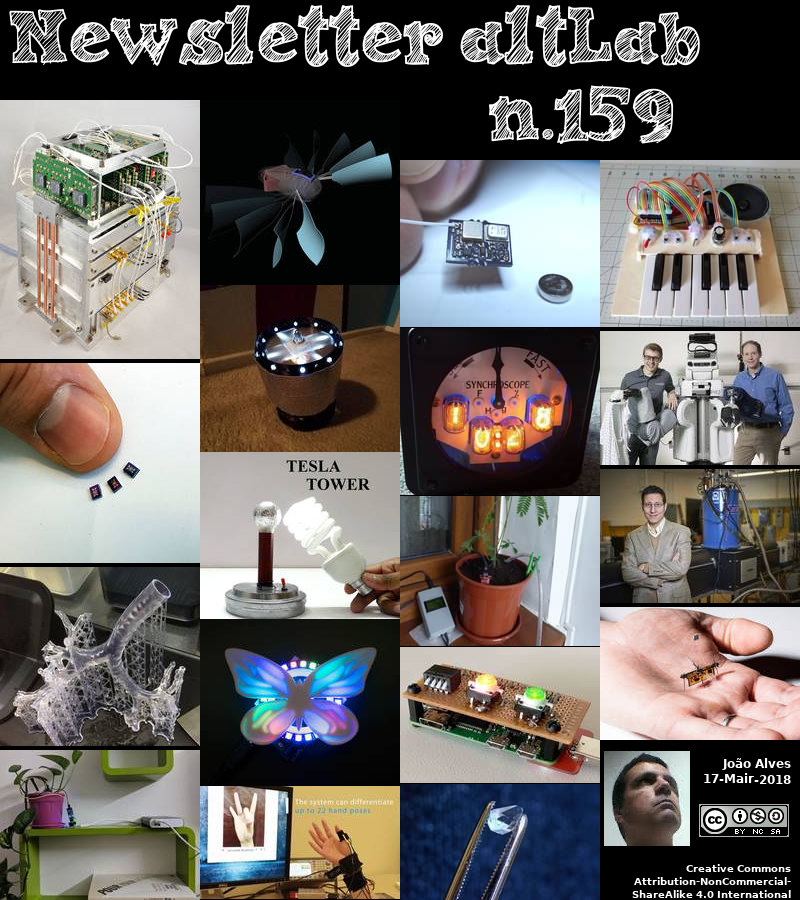
Editorial
Esta é a Newsletter Nº 159 que se apresenta com o mesmo formato que as anteriores. Se gostar da Newsletter partilhe-a!
Todas as Newsletters encontram-se indexadas no link.
Esta Newsletter tem os seguintes tópicos:
Faz hoje anos que nascia, em 1749, Edward Jenner. Este médico e cirurgião inglês descobriu a vacina para a varíola. Existia uma história entre os agricultores de que, se uma pessoa contraísse uma doença relativamente leve e inofensiva do gado, chamada de varíola bovina, ganharia imunidade à varíola. Em 14 de maio de 1796, ele removeu o líquido da varíola bovina da leiteira Sarah Nelmes e inoculou James Phipps, um menino de oito anos, que logo sofreu de varíola bovina. Seis semanas depois, ele inoculou o menino com varíola. O menino permaneceu saudável, provando a teoria. Ele chamou seu método de vacinação, usando a palavra latina vacca, que significa vaca, e vaccinia, que significa varíola bovina. Jenner também introduziu a palavra vírus.
Faz também hoje anos que nascia, em 1836, Joseph Norman Lockyer. Este astrónomo inglês descobriu, em 1868, e deu nome ao elemento hélio que encontrou na atmosfera do Sol antes de ser detectado na Terra. Ele também aplicou o nome cromosfera para a camada externa do sol. Lockyer descobriu, junto com Pierre J. Janssen, as proeminências (chamas vermelhas) que envolvem o disco solar. Ele também estava interessado na classificação de espectros estelares e desenvolveu a hipótese meteórica de evolução estelar. Os seus trabalhos incluem os livros Contributions to Solar Physics (1873), The Sun's Place in Nature (1897) e Inorganic Evolution (1900).
Faz igualmente hoje anos que nascia, em 1868, Horace Elgin Dodge. Este fabricante de automóveis americano, com seu irmão John Francis Dodge, foram fabricantes de automóveis americanos que inventaram um dos primeiros carros de aço na América. Eles construíram seu primeiro carro Dodge em Novembro de 1914 em Detroit, Michigan.
Por fim, faz anos hoje que nascia, em 1897, Odd Hassel. Este Físico-Químico norueguês recebeu (com Sir Derek H.R. Barton da Grã-Bretanha) o Prémio Nobel da Química em 1969 pelo seu trabalho no estabelecimento de análises conformacionais (o estudo da estrutura geométrica tridimensional de moléculas). Um anel de seis átomos de carbono tem duas conformações - a forma de cadeira e de barco. Estes trocam-se facilmente - cerca de um milhão de vezes por segundo à temperatura ambiente. Uma das conformações é, no entanto, fortemente predominante (cerca de 99%). Hassel realizou investigações fundamentais sobre esse sistema e mostrou como grupos pesados ou volumosos, ligados aos átomos de carbono, assumem as suas posições em relação ao anel e uns aos outros. Este trabalho é de grande importância para prever o modo de reacção de uma determinada molécula.
Hoje comemora-se o dia da Internet. Em Outubro de 1969, separados a uma distância de mais de 500 km, dois computadores fizeram a ligação que iria revolucionar as comunicações para sempre. Quase meio século depois mais de metade da população mundial já está ligada à grande rede.
A Intel faz 50 anos. Inicialmente, a empresa dedicava-se inteiramente à pesquisa e desenvolvimento, querendo aproveitar ao máximo seu novo começo e desenvolver novas tecnologias, em vez de apenas replicar as antigas. Para desenvolver um produto o mais rápido possível, a empresa foi buscar três tecnologias ao mesmo tempo: memória bipolar, um produto que usava tecnologia estabelecida, mas era difícil de desenvolver; memória de semicondutor de metal-óxido da porta de silício, que poderia revolucionar a fabricação de chips, mas precisava ser inventada primeiro; e memória multichip, em que quatro pequenos chips de memória foram ligados para criar um dispositivo que era volumoso e frágil, mas barato. Qualquer que fosse o dispositivo que comprovasse sua viabilidade, o mais rápido se tornaria o primeiro produto da Intel. Em abril de 1969, a Intel lançou seu primeiro produto: o chip 3101 de memória de acesso aleatório estática.
Na passada sexta-feira, 11 de maio às 16h14 EDT, a SpaceX lançou com sucesso o Bangabandhu Satellite-1 do histórico complexo de lançamento 39A (LC-39A) no Kennedy Space Center da NASA na Florida. Após a separação da frente do foguetão, o primeiro estágio do Falcon 9 aterrou com sucesso na barcaça “Of Course I Still Love You", o droneship da SpaceX estacionado no Oceano Atlântico. O Falcon 9 colocou o Bangabandhu Satellite-1 numa órbita de transferência geo-estacionária tendo o Satélite sido libertado aproximadamente 33 minutos após a descolagem. A missão Bangabandhu Satellite-1 serviu como o primeiro voo do Falcon 9 Block 5, a ultima actualização relevante para o foguetão Falcon 9 da SpaceX. O Falcon 9 Block 5 foi projectado para ser capaz de 10 ou mais voos com intervenção muito limitada, uma vez que a SpaceX continua a procura da reutilização rápida e segurança extremamente alta.
E na passada terça-feira, o asteróide 2010 WC9 fez um Flyby invulgarmente próximo da Terra. Passando pela Terra a uma distância segura de 203.000 quilómetros, ou cerca de metade da distância entre a Terra e a Lua, o asteróide, que é oficialmente designado como WC9 2010, fez a sua aproximação mais próxima às 18h05. EDT (2205 GMT), enquanto viajava a uma velocidade de 46,116 km/h, de acordo com o Minor Planet Center. Os astrónomos estimam que o asteróide mede de 38 a 119 metros de diâmetro.
Nesta semana apresentamos diversos projetos de maker assim como um modelo 3D que poderá ser útil.
 João Alves ([email protected])
João Alves ([email protected])
O conteúdo da Newsletter encontra-se sob a licença  Creative Commons Attribution-NonCommercial-ShareAlike 4.0 International License.
Creative Commons Attribution-NonCommercial-ShareAlike 4.0 International License.
Novidades da Semana
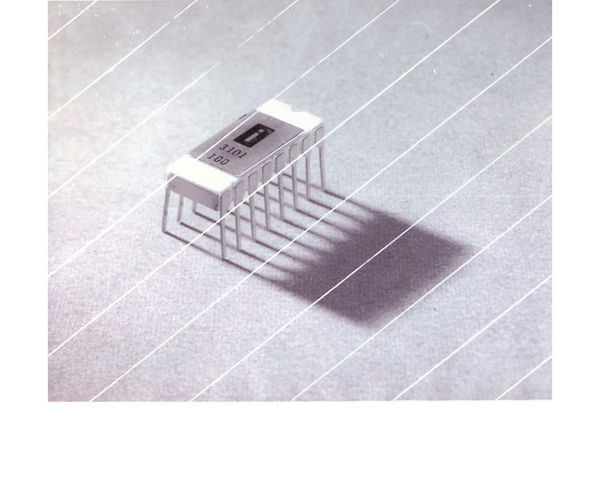
Intel at 50: Intel's First Product - the 3101
"In April 1969, Intel introduced its first product: the 3101 static random access memory. Intel had begun operations less than a year earlier, in August 1968. At first, the company dedicated itself wholly to research and development, wanting to make the most of its fresh start and develop new technologies instead of just replicating old ones. To develop a product as quickly as possible, the company had pursued three technologies at once: bipolar memory, a product that used established technology but was hard to develop; silicon gate metal-oxide semiconductor memory, which could revolutionize chipmaking but needed to be invented first; and multichip memory, in which four small memory chips were linked together to create a device that was bulky and fragile but cheap. Whichever device proved its viability the fastest would become Intel’s first product. The winner turned out to be the bipolar memory, the 64-bit 3101, a product whose speed in development was a victory in itself." [...]

BANGABANDHU Satellite-1 Mission
"On Friday, May 11th at 4:14 p.m. EDT, SpaceX successfully launched Bangabandhu Satellite-1 from historic Launch Complex 39A (LC-39A) at NASA’s Kennedy Space Center in Florida. Following stage separation, Falcon 9’s first stage successfully landed on “Of Course I Still Love You,” SpaceX’s droneship stationed in the Atlantic Ocean. Falcon 9 delivered Bangabandhu Satellite-1 to a geostationary transfer orbit and the spacecraft was deployed approximately 33 minutes after liftoff. The Bangabandhu Satellite-1 mission served as the first flight of Falcon 9 Block 5, the final substantial upgrade to SpaceX’s Falcon 9 launch vehicle. Falcon 9 Block 5 is designed to be capable of 10 or more flights with very limited refurbishment as SpaceX continues to strive for rapid reusability and extremely high reliability. " [...]

'Lost' Asteroid 2010 WC9 Will Make an Unusually Close Flyby of Earth Today
"A jumbo-jet-size asteroid will give Earth a close shave today (May 15), whizzing past our planet at a safe distance of 126,000 miles (203,000 kilometers) — or about half the distance between Earth and the moon. The asteroid, which is officially designated 2010 WC9, will make its closest approach at 6:05 p.m. EDT (2205 GMT) while traveling at a speed of 28,655 mph (46,116 km/h), according to the Minor Planet Center. Astronomers estimate that the asteroid measures 125 to 390 feet (38 to 119 meters) in diameter. That means it's about as big as New York City's Statue of Liberty, though it could be even longer than a football field. [Images: Potentially Dangerous Asteroids] While this isn't exceptionally large for a near-Earth asteroid, it is rare for asteroids this big to venture so close to Earth. According to EarthSky.org, this will be "one of the closest approaches ever observed of an asteroid of this size."" [...]
Outras Notícias

Toshiba Redefines the Limit of Intercity Secure Communications
"Twin-Field QKD allows secure quantum key distribution over 500 km of optical fibre The Cambridge Research Laboratory of Toshiba Research Europe Ltd today announced that it has devised a new protocol for quantum key distribution (QKD) that will extend its range to over 500 km of standard telecom fibre. This advance, called Twin-Field QKD, enables the protection of sensitive data transmitted in optical networks between cities. It would allow a secure link between cities like London, Paris, Brussels, Amsterdam or Dublin. The details of the breakthrough are published today in the scientific journal, Nature. QKD can be used to distribute the secret digital keys important for protecting our personal data, such as bank statements, health records, and digital identity. Its security relies on encoding each bit of the key upon a single photon (particle of light) transmitted, e.g., through an ordinary optical fibre." [...]
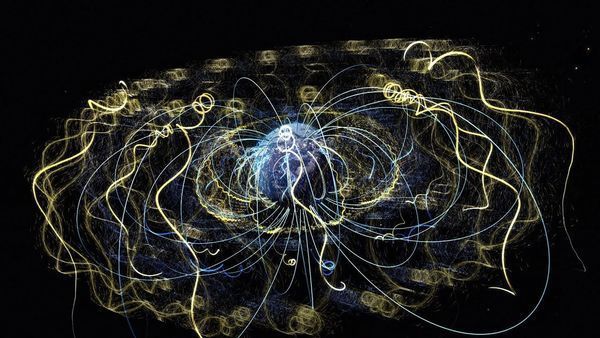
NASA Spacecraft Discovers New Magnetic Process in Turbulent Space
"Though close to home, the space immediately around Earth is full of hidden secrets and invisible processes. In a new discovery reported in the journal Nature, scientists working with NASA’s Magnetospheric Multiscale spacecraft — MMS — have uncovered a new type of magnetic event in our near-Earth environment by using an innovative technique to squeeze extra information out of the data. Magnetic reconnection is one of the most important processes in the space — filled with charged particles known as plasma — around Earth. This fundamental process dissipates magnetic energy and propels charged particles, both of which contribute to a dynamic space weather system that scientists want to better understand, and even someday predict, as we do terrestrial weather. Reconnection occurs when crossed magnetic field lines snap, explosively flinging away nearby particles at high speeds. The new discovery found reconnection where it has never been seen before — in turbulent plasma." [...]

Arduino goes to college with the new Arduino Engineering Kit!
"We’re excited to announce the Arduino Engineering Kit, the first product released as a result of our new partnership with MathWorks, to reinforce the importance of Arduino at the university level in the fields of engineering, Internet of Things, and robotics. The Arduino Engineering Kit, which will be available for purchase starting today on the Arduino online store, consists of three cutting-edge, Arduino-based projects and will teach students how to build modern electronic devices – challenging them intellectually and helping them develop physical engineering skills that will better prepare them to enter the commercial market following graduation. In addition to the hardware, after registering online, students and educators will have access to a dedicated e-learning platform and other learning materials. The kit also includes a one-year individual license for MATLAB and Simulink, providing the user with hands-on experience in system modeling and embedded algorithm development. Following the global success of Arduino CTC 101, a program tailored for upper secondary schools, the Arduino Engineering Kit enables college students and educators to incorporate core engineering concepts like control systems, inertial sensing, signal and imaging processing, and robotics with the support of MATLAB and Simulink programming. These software packages are the base of industry-standard tools for algorithm development, system modeling, and simulation, all of which will be required in their future careers." [...]

Please Touch: 3D Printed Anatomy Can Make Surgery A Hands-On Experience For Everyone
"About three years ago, Dr. Beth Ripley had a patient in denial. Though Ripley and several other radiologists identified a tumor growing on the woman’s kidney, she refused to believe it — mainly because the treatment, a surgery involving removing her entire kidney, sounded terrifying. The patient and doctors were at a standstill until a surgeon presented the woman with a model of the cancerous organ Ripley made from a medical scan on a 3D printer. Not only did she instantly grasp her situation, but the surgeon had an epiphany of his own. “He was able to see that he could take out the tumor without removing the entire kidney,” Ripley says. Now Ripley is bringing such light-bulb moments to the largest medical provider in the United States — Veterans Affairs hospitals." [...]
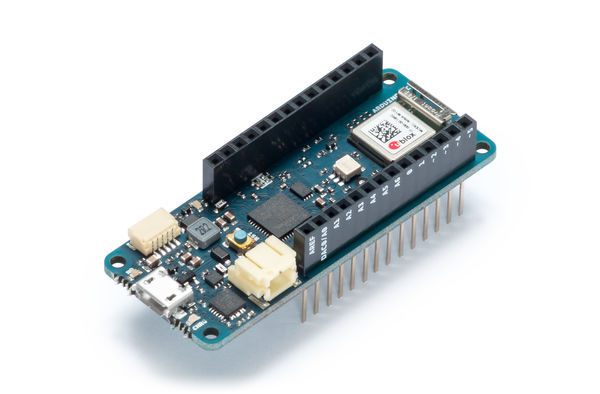
The MKR family gets bigger with two new IoT boards!
"We’re excited to announce two new wireless connectivity boards to help streamline Internet of Things development, the MKR WiFi 1010 and MKR NB 1500. The first of the boards is the MKR WiFi 1010, which offers low power consumption and has been designed not only to speed up and simplify the prototyping of WiFi-based IoT applications, but also to be embedded in production IoT applications that require WiFi connectivity. The board is an evolution of the existing Arduino MKR1000, but now comes equipped with an ESP32-based module manufactured by u-blox. This key element delivers 2.4GHz WiFi and Bluetooth communications capability, along with leading RF and power performance: the ESP32 is a highly flexible device that provides adjustable power output, enabling optimal trade-offs between communication range, data rate and power consumption. Fully compatible with the Arduino IT cloud, the MKR1010 also offers simple migration from other Arduino boards, and uses open-source WiFi firmware, which makes it easy to reprogram for upgrading or to repair any security flaws. A significant feature is the MKR1010’s two standalone programmable processors – the first based on ARM processor core technology, the second based on a dual-core Espressif IC – making the board a high-performance solution that can distribute its workload across its dual-processor system." [...]
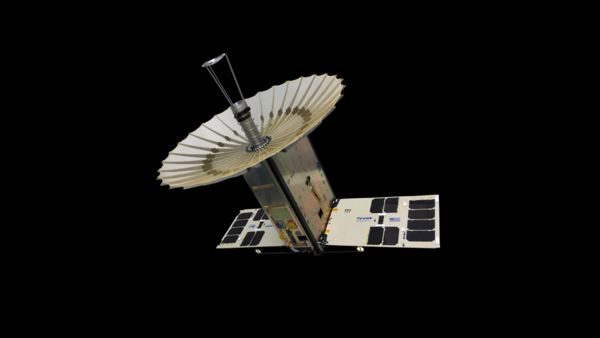
Small Packages to Test Big Space Technology Advances
"This weekend, when the next cargo resupply mission to the International Space Station lifts off from NASA Wallops Flight Facility in Virginia, it will be carrying among its supplies and experiments three cereal box-sized satellites that will be used to test and demonstrate the next generation of Earth-observing technology. NASA has been increasing its use of CubeSats -- small satellites based on several configurations of approximately 4 x 4 x 4-inch cubes -- to put new technologies in orbit where they can be tested in the harsh environment of space before being used as part of larger satellite missions or constellations of spacecraft. The three CubeSat missions launching on Orbital ATK's ninth commercial resupply mission represent a broad range of cutting-edge technologies housed in very small packages. RainCube -- a Radar in a CubeSat -- is just that: a miniaturized precipitation-studying radar instrument that weighs just over 26 pounds. RainCube is smaller, has fewer components, and uses less power than traditional radar instruments. NASA's Earth Science Technology Office (ESTO) In-Space Validation of Earth Science Technologies (InVEST) program selected the project to demonstrate that such a diminutive radar can be operated successfully on a CubeSat platform." [...]

Intel at 50: Intel's 1101
"Intel’s 1101 static random access memory (SRAM) was the first high-volume metal-oxide semiconductor (MOS) memory and the first chip to use silicon gates. The device was the result of a challenging development process. The conceptual groundwork for metal-oxide semiconductor memory had been established before Intel’s founding, but no one was even close to a commercially viable mass production method. The task of developing one was daunting. Tom Rowe, Intel’s first process engineer, recalled that the largest obstacle was getting a high die yield out of a wafer (Intel’s goal was 20 die per wafer), a problem he feared might be intractable: “Every time we’d fix a problem, we’d uncover another one. … For all we knew the silicon gate process was no good." [...]
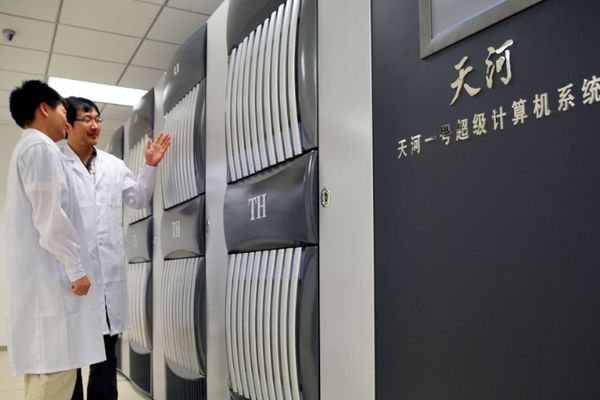
Planned supercomputer would be 10 times faster than today's No 1
"The National Supercomputing Center in Shenzhen plans to build a next-generation supercomputer that will be 10 times faster than the world's current speed champion, a senior executive said. "The investment is likely to hit 3 billion yuan ($470.6 million), and key technologies for the supercomputer are expected to be developed independently," Wang Zhenglu, director of the project management department of the center told China Daily. The supercomputer will be "exascale", meaning that it will be capable of making a quintillion (1 followed by 18 zeros) calculations per second, much faster than the current No 1 supercomputer, Sunway TaihuLight, Wang said. The new supercomputer is expected to be developed by 2020. The exascale supercomputer will play an important role in promoting the development of the Guangdong-Hong Kong-Macao Greater Bay Area, especially in cloud computing, big data and artificial intelligence, he said. Supercomputers are a new driving force in China's computer innovation and are important for the nation's information security." [...]
Ciência e Tecnologia
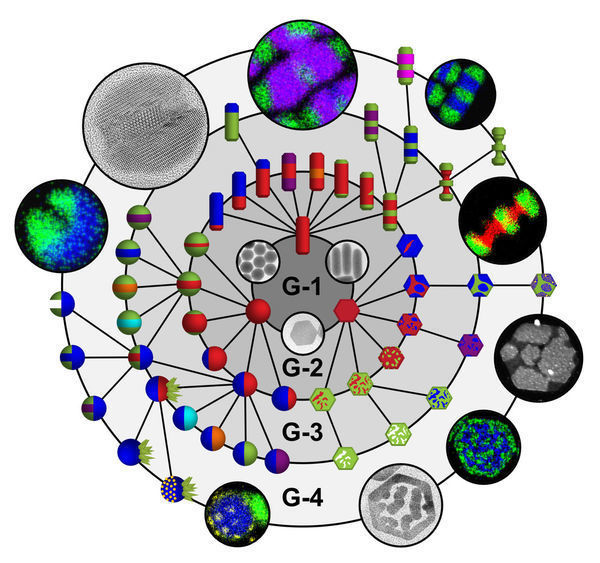
A designer's toolkit for constructing complex nanoparticles
"A team of chemists at Penn State has developed a designer’s toolkit that lets them build various levels of complexity into nanoparticles using a simple, mix-and-match process. “Researchers in areas as diverse as medicine, energy and electronics often design complex nanoscale particles that are predicted to have useful functions,” said Raymond E. Schaak, DuPont Professor of Materials Chemistry at Penn State and the leader of the research team. “But making them in the laboratory is often the bottleneck. Our strategy can help to streamline this process.” A paper describing the team’s strategy and the large library of particles that they can now make appears May 4 in the journal Science. Scientists and engineers are getting better and better at designing nanoparticles to split water using sunlight, to diagnose and treat cancer, and to solve other important problems. Many of these ‘designer’ particles need to include various types of semiconductors, catalysts, magnets and other materials to function, all while meeting strict requirements involving their size and shape." [...]
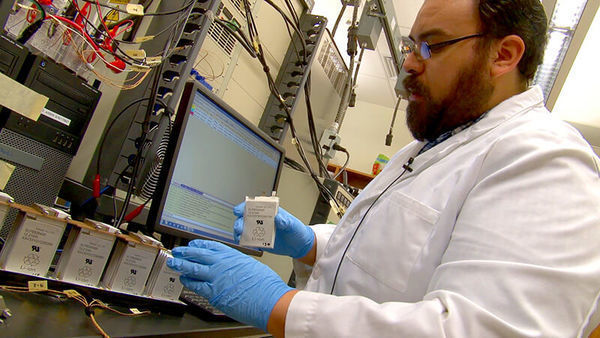
Making safer and more powerful lithium-ion batteries requires the right recipe
"A Purdue University team has published research that examines the relationship between the active and inactive elements of lithium-ion batteries, and how the micro- and nano-structure of their respective ingredients reflects on the performance and safety of the batteries. The study was recently featured on the front cover of the journal ACS Applied Materials & Interfaces. “Rechargeable batteries are everywhere,” said Partha Mukherjee, associate professor of mechanical engineering, and principal investigator of the research. “We probably carry two or three portable electronics with us at all times. But the interactions between the different elements of the battery itself are still not clearly understood. My research hopes to bridge that gap.” In Mukherjee’s lab, the Energy and Transport Sciences Laboratory (ETSL), researchers study all forms of energy transport and storage, including batteries and fuel cells." [...]
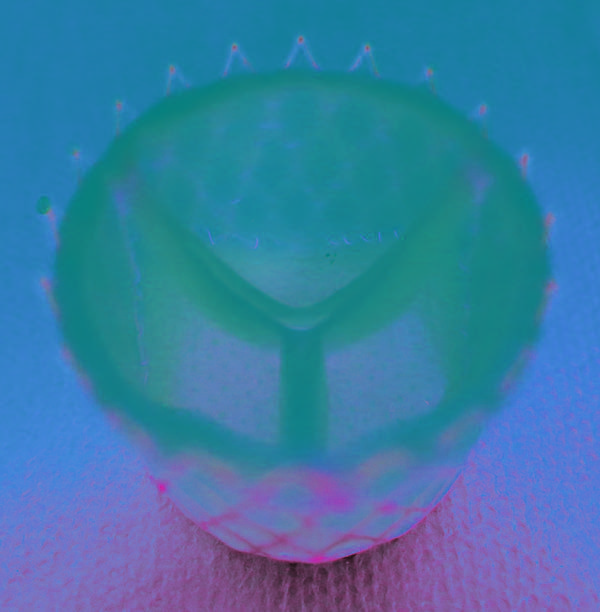
Computer-Designed Customized Regenerative Heart Valves
"Cardiovascular tissue engineering aims to treat heart disease with prostheses that grow and regenerate. Now, researchers from the University of Zurich, the Technical University Eindhoven and the Charité Berlin have successfully implanted regenerative heart valves, designed with the aid of computer simulations, into sheep for the first time. Producing living tissue or organs based on human cells is one of the main research fields in regenerative medicine. Tissue engineering, which involves growing replacement parts in the laboratory, forms a key part of this research. The parts can be used to replace defective cells and tissues in the body and restore their normal functioning. The bioengineered replacements have significant advantages over the artificial implants currently in use: They do not cause immune reactions in the patient’s body, and they can grow and regenerate themselves." [...]
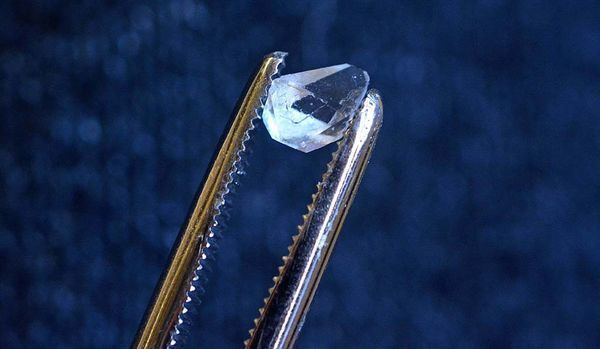
Yale physicists find signs of a time crystal
"Yale physicists have uncovered hints of a time crystal — a form of matter that “ticks” when exposed to an electromagnetic pulse — in the last place they expected: a crystal you might find in a child’s toy. The discovery means there are now new puzzles to solve, in terms of how time crystals form in the first place. Ordinary crystals such as salt or quartz are examples of three-dimensional, ordered spatial crystals. Their atoms are arranged in a repeating system, something scientists have known for a century. Time crystals, first identified in 2016, are different. Their atoms spin periodically, first in one direction and then in another, as a pulsating force is used to flip them." [...]

Revealing the mysteries of superconductors: Ames Lab's new scope takes a closer look
"The U.S. Department of Energy’s Ames Laboratory has successfully demonstrated that a new type of optical magnetometer, the NV magnetoscope, can map a unique feature of superconductive materials that along with zero resistance defines the superconductivity itself. That unique feature is the Meissner effect, which is the expulsion of the magnetic field during a material’s transition to a superconducting state. “The Meissner effect is the hallmark signature of a true superconductor, which separates it from a hypothetical perfect metal with zero resistance,” said Ruslan Prozorov, an Ames Laboratory physicist who is an expert in superconductivity and magnetism at low temperatures. “That is fine in textbooks and in principle, but in real superconducting materials the Meissner effect is quite complicated. Robust screening of a magnetic field by a superconducting sample and Meissner expulsion upon cooling in a magnetic field can be confused. This effect is actually very weak and fragile and difficult to observe.” Until now, physicists have been able to observe the Meissner effect, but were unable to visualize its spatial distribution in the material and how that might vary between different superconducting compounds." [...]
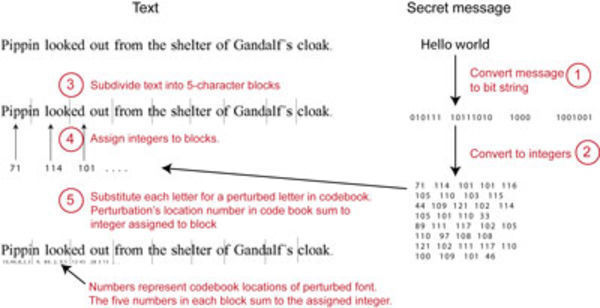
Researchers Hide Information in Plain Text
"Columbia computer scientists invent FontCode, a way to embed hidden information in ordinary text by imperceptibly changing the shapes of fonts in text. Method could prevent document tampering, protect copyrights, as well as embed QR codes and other metadata without altering the look or layout of a document. Computer scientists at Columbia Engineering have invented FontCode, a new way to embed hidden information in ordinary text by imperceptibly changing, or perturbing, the shapes of fonts in text. FontCode creates font perturbations, using them to encode a message that can later be decoded to recover the message. The method works with most fonts and, unlike other text and document methods that hide embedded information, works with most document types, even maintaining the hidden information when the document is printed on paper or converted to another file type. The paper will be presented at SIGGRAPH in Vancouver, British Columbia, August 12-16." [...]
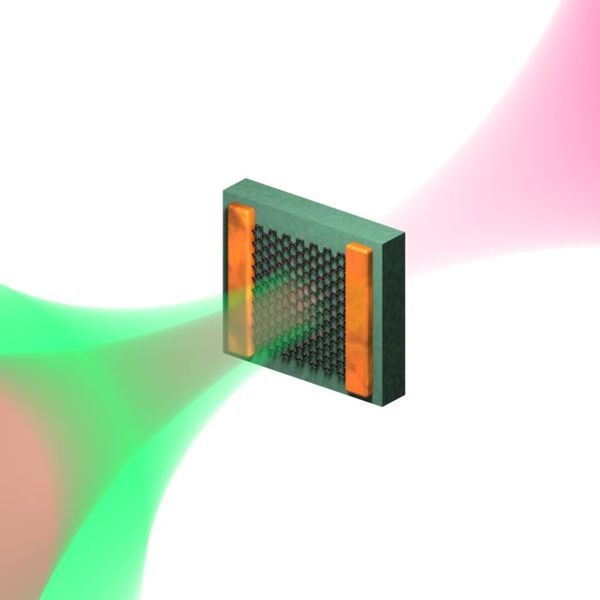
The photoexcited graphene puzzle solved
"A boost for graphene-based light detectors Light detection and control lies at the heart of many modern device applications, such as the camera you have in your phone. Using graphene as a light-sensitive material for light detectors can offer significant improvements with respect to materials being used nowadays. For example, graphene can detect light of almost any colour, and it gives an extremely fast electronic response within one millionth of a millionth of a second. Thus, in order to properly design graphene-based light detectors it is crucial to understand the processes that take place inside the graphene after it absorbs light. ICFO researchers Klaas-Jan Tielrooij and ICREA Prof. at ICFO Frank Koppens, in collaboration with scientists from European research centers, have now succeeded in understanding these processes. Published recently in Science Advances, their work gives a thorough explanation of why, in some cases, the graphene conductivity increases after light absorption and in other cases, it decreases." [...]

Frequency-stable laser systems for space
"JOKARUS experiment on sounding rocket successfully completed. Corner stone for laser ranging measurements with the highest precision and precursor for optical sat-ellite navigation systems. For the first time a frequency reference based on molecular iodine was successfully demonstrated in space! What sounds a bit like science fiction is an important step towards laser interferometric dis-tance measurements between satellites as well as for future global navigation satellite systems based on optical technologies. The frequency reference tests were carried out on 13 May on board the sounding rocket TEXUS54. The centerpiece of the payload, a compact laser system, which was pri-marily developed by HU Berlin and the Ferdinand-Braun-Institut, demonstrated its suitability for space." [...]

Hanging by a Nanowhisker
"If Alexander Yulaev and his colleagues had their druthers, they’d do away with whiskers altogether. These scientists don’t have anything against facial hair, but they would love to eliminate the whisker-like filaments that can short out the next-generation lithium batteries that are potentially safer and more efficient than conventional lithium-ion batteries. Using real-time nanoscale imaging techniques, researchers at the National Institute of Standards and Technology (NIST) and their colleagues have now documented the movement of lithium as it cycles across a next-generation lithium battery made entirely of solid components. By studying lithium cycling in different environments—when exposed to varying concentrations of molecular oxygen—the team determined the optimal conditions to avoid or stem the growth of lithium whiskers. A technology still in its infancy, lithium solid-state batteries may ultimately supersede the industry standard for the past 25 years, the lithium-ion battery. A standard lithium-ion battery contains a liquid electrolyte." [...]

UTA researchers develop highly elastic biodegradable hydrogel for bio-printing of new tissues
"Researchers at The University of Texas at Arlington have developed a highly elastic biodegradable hydrogel for bio-printing of materials that mimic natural human soft tissues. Bio-printing uses live cells within the scaffolding of the new tissues and could potentially transform cell printing. A provisional patent application has been filed on this new material, which will be able to generate multiple types of human soft tissues, including skin, skeletal muscles, blood vessels and heart muscles. “Soft tissue bio-printing suffers from significant challenges as the hydrogels were often brittle and un-stretchable and could not mimic the mechanical behavior of human soft tissues,” said Yi Hong, UTA professor of bioengineering and leader of the project. “To overcome these challenges, we developed a simple system using a single cross-linking mechanism activated by visible light to achieve a highly elastic and robust, biodegradable and biocompatible hydrogel for cell printing,” Hong added. The researchers have described their findings in a new journal paper published recently in the American Chemical Society’s ACS Applied Materials and Interfaces as as “Highly Elastic Biodegradable Single-Network Hydrogel for Cell Printing.” The paper was also selected as an American Chemical Society Editors’ Choice." [...]

Waterloo chemists create faster and more efficient way to process information
"University of Waterloo chemists have found a much faster and more efficient way to store and process information by expanding the limitations of how the flow of electricity can be used and managed. In a recently released study, the chemists discovered that light can induce magnetization in certain semiconductors – the standard class of materials at the heart of all computing devices today. “These results could allow for a fundamentally new way to process, transfer, and store information by electronic devices, that is much faster and more efficient than conventional electronics.” For decades, computer chips have been shrinking thanks to a steady stream of technological improvements in processing density. Experts have, however, been warning that we’ll soon reach the end of the trend known as Moore’s Law, in which the number of transistors per square inch on integrated circuits double every year. “Simply put, there’s a physical limit to the performance of conventional semiconductors as well as how dense you can build a chip,” said Pavle Radovanovic, a professor of chemistry and a member of the Institute for Nanotechnology. “In order to continue improving chip performance, you would either need to change the material transistors are made of - from silicon, say to carbon nanotubes or graphene - or change how our current materials store and process information.” Radovanovic’s finding is made possible by magnetism and a field called spintronics, which proposes to store binary information within an electron’s spin direction, in addition to its charge and plasmonics, which studies collective oscillations of electrons in a material." [...]
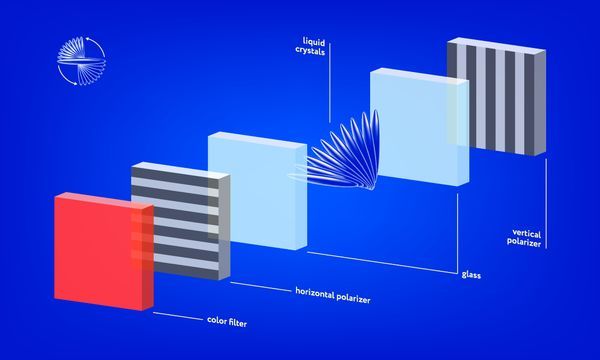
Researchers offer new technology for liquid-crystal displays
"An international research team from Russia, France, and Germany has proposed a new method for orienting liquid crystals. It could be used to increase the viewing angle of liquid-crystal displays. The paper was published in the journal ACS Macro Letters. “This is first and foremost a fundamental study exploring the mechanisms of liquid crystal orientation,” says Dimitri Ivanov, the head of the Laboratory of Functional Organic and Hybrid Materials at MIPT. “That said, we expect that these mechanisms might have applications in new LCD technology.” Liquid crystals Most solids are crystals. In a crystal, molecules or atoms form an ordered three-dimensional structure." [...]

Insight into quantum chaos may be the key to quantum computers
"New research gives insight into a recent experiment that was able to manipulate an unprecedented number of atoms through a quantum simulator. A recent experiment by Harvard University and MIT developed a specialized quantum computer, known as a quantum simulator, which could be used to help understand complex quantum processes. The new research, led by the University of Leeds, has provided a theoretical explanation for the particular behaviour of individual atoms that were trapped and manipulated in the experiment. Manipulating quantum bits of matter The Harvard University and MIT experiment used a system of finely tuned lasers to act as “optical tweezers” to assemble a remarkably long chain of 51 atoms. When the quantum dynamics of the atom chain were measured, there were surprising oscillations that persisted for much longer than expected and which couldn’t be explained. The international team of researchers examining the behaviour included scientists from the School of Physics and Astronomy, the Institute of Science and Technology Austria and the University of Geneva." [...]

Wearable Ring, Wristband Allow Users to Control Smart Tech With Hand Gestures
"New technology created by a team of Georgia Tech researchers could make controlling text or other mobile applications as simple as “1-2-3.” Using acoustic chirps emitted from a ring and received by a wristband, like a smartwatch, the system is able to recognize 22 different micro finger gestures that could be programmed to various commands — including a T9 keyboard interface, a set of numbers, or application commands like playing or stopping music. A video demonstration of the technology shows how, at a high rate of accuracy, the system can recognize hand poses using the 12 bones of the fingers and digits ‘1’ through ‘10’ in American Sign Language (ASL). “Some interaction is not socially appropriate,” said Cheng Zhang, the Ph.D. student in the School of Interactive Computing who led the effort. “A wearable is always on you, so you should have the ability to interact through that wearable at any time in an appropriate and discreet fashion. When we’re talking, I can still make some quick reply that doesn’t interrupt our interaction.” The system is also a preliminary step to being able to recognize ASL as a translator in the future, Zhang said. Other techniques utilize cameras to recognize sign language, but that can be obtrusive and is unlikely to be carried everywhere." [...]

Robot Teaches Itself How to Dress People
"More than 1 million Americans require daily physical assistance to get dressed because of injury, disease and advanced age. Robots could potentially help, but cloth and the human body are complex. To help address this need, a robot at the Georgia Institute of Technology is successfully sliding hospital gowns on people’s arms. The machine doesn’t use its eyes as it pulls the cloth. Instead, it relies on the forces it feels as it guides the garment onto a person’s hand, around the elbow and onto the shoulder. The machine, a PR2, taught itself in one day, by analyzing nearly 11,000 simulated examples of a robot putting a gown onto a human arm." [...]

New Material for Generating Energy-Efficient Spin Currents
"Magnetic random access memory (MRAM) is emerging as next-generation memory. It allows information to be kept even without an external power supply and its unique blend of high density and high speed operation is driving global semiconductor manufacturers to develop new versions continuously. A KAIST team, led by Professor Byong-Guk Park in the Department of Materials Science and Engineering and Professor Kab-Jin Kim in the Department of Physics, recently has developed a new material which enables the efficient generation of a spin current, the core part of operating MRAM. This new material consisting of ferromagnet-transition metal bilayers can randomly control the direction of the generated spin current unlike the existing ones. They also described a mechanism for spin-current generation at the interface between the bottom ferromagnetic layer and the non-magnetic spacer layer, which gives torques on the top magnetic layer that are consistent with the measured magnetization dependence. When applying this to spin-orbit torque magnetic memory, it shows the increased efficiency of spin torque and generation of the spin current without an external magnetic field." [...]
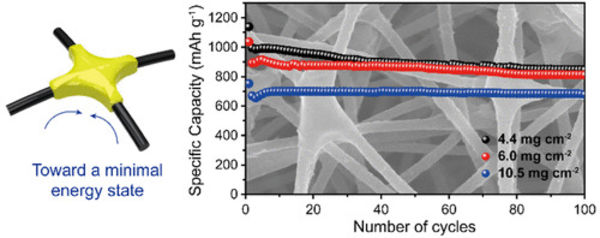
Capillary Forces at Work for Lithium-Sulfur Batteries
"Professor Do Kyung Kim from the KAIST Department of Materials Science and Engineering and his team succeeded in developing high-areal-capacity lithium sulfur batteries (Li-S batteries) by capturing polysulfide with carbon nanofibers. This research will provide new batteries to replace existing lithium rechargeable batteries, shifting the commercialization of related technologies ahead. Electrical vehicles and large-scale energy storage systems necessitate the development of batteries with high energy density and cost effectiveness, and Li-S batteries are known to be one of the promising alternatives to the predominant lithium ion batteries. With six times as much energy density, Li-S batteries theoretically thrust electric vehicle to twice the distance of lithium ion batteries. Therefore, they have been spotlighted as next-generation lithium rechargeable batteries because they can go up to 400km once charged. However, several issues make it challenging to readily commercialize Li-S batteries." [...]
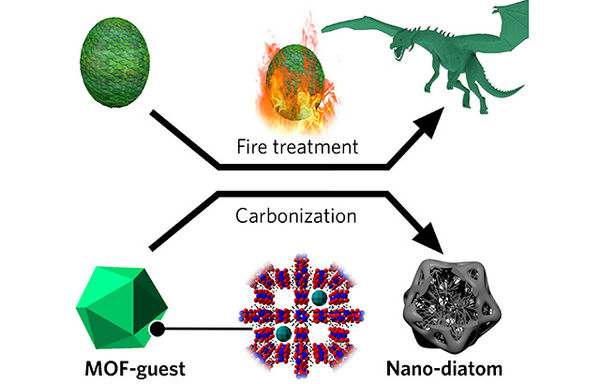
Scientists discover how a pinch of salt can improve battery performance
"Researchers at Queen Mary University of London, University of Cambridge and Max Planck Institute for Solid State Research have discovered how a pinch of salt can be used to drastically improve the performance of batteries. They found that adding salt to the inside of a supermolecular sponge and then baking it at a high temperature transformed the sponge into a carbon-based structure. Surprisingly, the salt reacted with the sponge in special ways and turned it from a homogeneous mass to an intricate structure with fibres, struts, pillars and webs. This kind of 3D hierarchically organised carbon structure has proven very difficult to grow in a laboratory but is crucial in providing unimpeded ion transport to active sites in a battery. In the study, published in JACS (Journal of the American Chemical Society), the researchers demonstrate that the use of these materials in Lithium-ion batteries not only enables the batteries to be charged-up rapidly, but also at one of the highest capacities. Due to their intricate architecture the researchers have termed these structures ‘nano-diatoms’, and believe they could also be used in energy storage and conversion, for example as electrocatalysts for hydrogen production." [...]
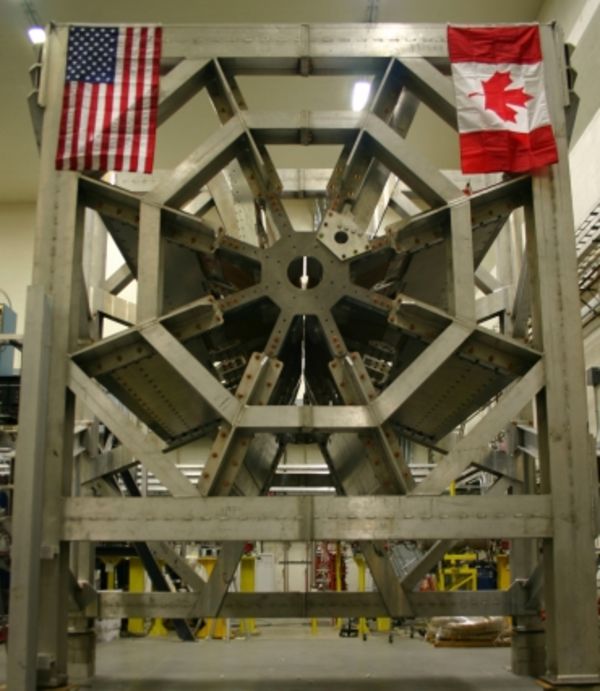
Understanding the proton's weak side
"Research from the Qweak experiment provides a precision measurement of the proton’s weak charge. narrows the search for new physics. A new result from the Qweak experiment at the U.S. Department of Energy’s Thomas Jefferson National Accelerator Facility provides a precision test of the weak force, one of four fundamental forces in nature. This result, published recently in Nature, also constrains possibilities for new particles and forces beyond our present knowledge. The Qweak experiment has set new standards in precision tests of the Standard Model, a highly successful theory of fundamental particles and their interactions. It directly probed the physics only reached at the highest energy particle accelerators." [...]

Safer Surgery: Engineer Seeks To Refine Robot-assisted Operations
"Tucked away in a central room at the University of Virginia’s Link Lab, the ultra-modern space on the top floor of School of Engineering and Applied Science’s Olsson Hall, sits a non-descript cart. The cart is surrounded by the state-of-the-art, robot-assisted surgery equipment that is at the heart of research by Homa Alemzadeh and her UVA colleagues into the safety and security of these cutting-edge instruments of medicine. On the bottom of the cart, sticking out amongst the new tools of the trade, sits the old-school children’s game, Operation. Why? Because Alemzadeh is a problem-solver, even solving problems before they present themselves. Explaining to children what the surgical robots actually do would be difficult, she knew." [...]

UCLA engineer develops 3D printer that can create complex biological tissues
"A UCLA bioengineer has developed a technique that uses a specially adapted 3D printer to build therapeutic biomaterials from multiple materials. The advance could be a step toward on-demand printing of complex artificial tissues for use in transplants and other surgeries. “Tissues are wonderfully complex structures, so to engineer artificial versions of them that function properly, we have to recreate their complexity,” said Ali Khademhosseini, who led the study and is UCLA’s Levi James Knight, Jr., Professor of Engineering at the UCLA Samueli School of Engineering. “Our new approach offers a way to build complex biocompatible structures made from different materials.” The study was published in Advanced Materials. The technique uses a light-based process called stereolithography, and it takes advantage of a customized 3D printer designed by Khademhosseini that has two key components. The first is a custom-built microfluidic chip — a small, flat platform similar in size to a computer chip — with multiple inlets that each “prints” a different material." [...]
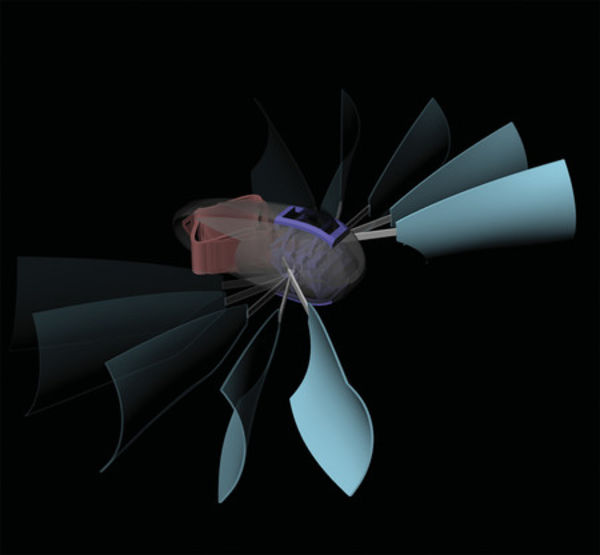
No Motor, No Battery, No Problem
"New robot concept uses responsive materials to swim through water Engineers at Caltech and ETH Zurich have developed robots capable of self-propulsion without using any motors, servos, or power supply. Instead, these first-of-their-kind devices paddle through water as the material they are constructed from deforms with temperature changes. The work blurs the boundary between materials and robots. In the self-propelled devices, the material itself makes the machine function. "Our examples show that we can use structured materials that deform in response to environmental cues, to control and propel robots," says Daraio, professor of mechanical engineering and applied physics in Caltech's Division of Engineering and Applied Science, and corresponding author of a paper unveiling the robots that appears in the Proceedings of the National Academy of Sciences on May 15. The new propulsion system relies on strips of a flexible polymer that is curled when cold and stretches out when warm." [...]
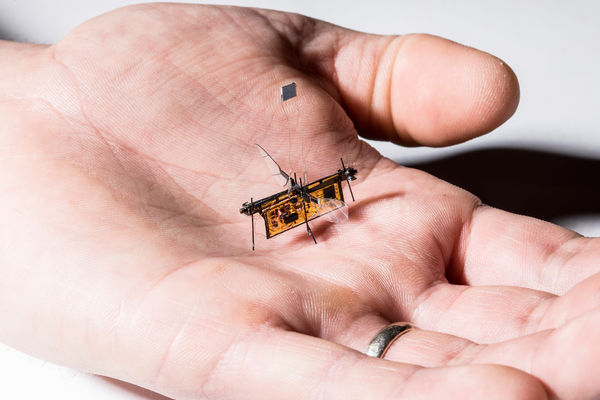
The first wireless flying robotic insect takes off
"Insect-sized flying robots could help with time-consuming tasks like surveying crop growth on large farms or sniffing out gas leaks. These robots soar by fluttering tiny wings because they are too small to use propellers, like those seen on their larger drone cousins. Small size is advantageous: These robots are cheap to make and can easily slip into tight places that are inaccessible to big drones. But current flying robo-insects are still tethered to the ground. The electronics they need to power and control their wings are too heavy for these miniature robots to carry. Now, engineers at the University of Washington have for the first time cut the cord and added a brain, allowing their RoboFly to take its first independent flaps." [...]
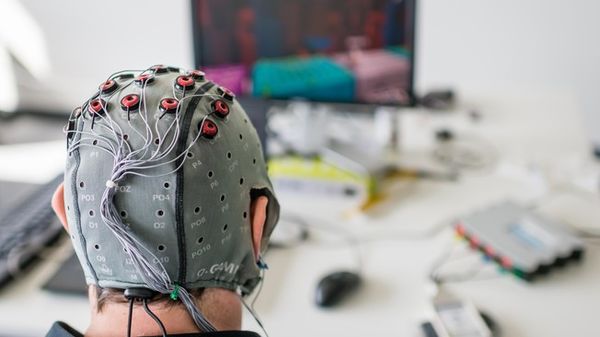
Humans and machines learn together to win a competition
"Brain-computer interfaces (BCIs) are seen as a potential means by which severely physically impaired individuals can regain control of their environment. BCIs use the electrical activity in the brain to control an external device. They have seen growing use in people with severe motor disabilities, for communication (by controlling a keyboard), mobility (by controlling a powered wheelchair), and daily activities (by controlling a mechanical arm or other robotic devices). But establishing such an interface is not trivial. In a study published in the open-access journal PLOS Biology, a group of researchers at the École Polytechnique Fédérale de Lausanne in Geneva (Campus Biotech), led by José del R. Millán -Defitech Foundation Chair in Brain-Machine Interface, School of Engineering, suggests that letting humans adapt to machines improves their performance on a brain-computer interface. The scientists trained two tetraplegic subjects to compete in the Cybathlon BCI race 2016, an international competition where competitors control an on-screen avatar with brain-computer interfaces." [...]

Further confirmation of quantum mechanics
"Nowadays, it is accepted among physicists that Albert Einstein was wrong in his scepticism of quantum mechanics. This was also confirmed by the Big Bell Test involving over 100,000 people around the world in November 2016. Quantum physics is a popular scientific discipline – or so it would seem from the Big Bell Test on 30 November 2016, which involved more than 100,000 people around the world. On the day, 12 scientific institutions, including ETH Zurich, explored a question once argued over by Niels Bohr and Albert Einstein in the 1930s. The researchers have reported in the latest edition of the journal Nature that the experiment – once again – confirms Nils Bohr’s point of view. The strange quantum world The starting point for the debate between the two famous physicists was the fact that quantum mechanics postulates phenomena that seem totally at odds with our everyday experiences." [...]
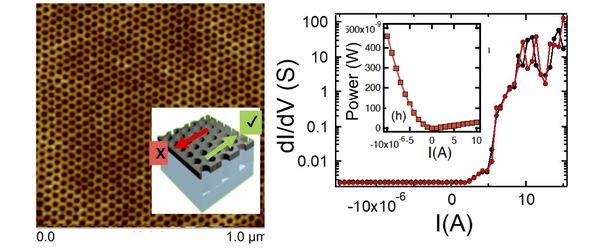
New device could increase battery life of electronic devices by more than a hundred-fold
"Among the chief complaints for smartphone, laptop and other battery-operated electronics users is that the battery life is too short and—in some cases—that the devices generate heat. Now, a group of physicists led by Deepak K. Singh, associate professor of physics and astronomy at the University of Missouri, has developed a device material that can address both issues. The team has applied for a patent for a magnetic material that employs a unique structure—a “honeycomb” lattice that exhibits distinctive electronic properties. “Semiconductor diodes and amplifiers, which often are made of silicon or germanium, are key elements in modern electronic devices,” said Singh, who also serves as the principal investigator of the Magnetism and Superconductivity Research Laboratory at MU. “A diode normally conducts current and voltage through the device along only one biasing direction, but when the voltage is reversed, the current stops. This switching process costs significant energy due to dissipation, or the depletion of the power source, thus affecting battery life." [...]

Researchers Control the Properties of Graphene Transistors Using Pressure
"A Columbia University-led international team of researchers has developed a technique to manipulate the electrical conductivity of graphene with compression, bringing the material one step closer to being a viable semiconductor for use in today’s electronic devices. “Graphene is the best electrical conductor that we know of on Earth,” said Matthew Yankowitz, a postdoctoral research scientist in Columbia’s physics department and first author on the study. “The problem is that it’s too good at conducting electricity, and we don’t know how to stop it effectively. Our work establishes for the first time a route to realizing a technologically relevant band gap in graphene without compromising its quality. Additionally, if applied to other interesting combinations of 2D materials, the technique we used may lead to new emergent phenomena, such as magnetism, superconductivity, and more.” The study, funded by the National Science Foundation and the David and Lucille Packard Foundation, appears in the May 17 issue of Nature. The unusual electronic properties of graphene, a two-dimensional (2D) material comprised of hexagonally-bonded carbon atoms, have excited the physics community since its discovery more than a decade ago." [...]

Processing Glass Like a Polymer
"KIT Materials Scientists Develop New Forming Technology – Publication in Advanced Materials Pure quartz glass is highly transparent and resistant to thermal, physical, and chemical impacts. These are optimum prerequi-sites for use in optics, data technology or medical engineering. For efficient, high-quality machining, however, adequate pro-cesses are lacking. Scientists of Karlsruhe Institute of Technolo-gy (KIT) have developed a forming technology to structure quartz glass like a polymer. This innovation is reported in the journal Advanced Materials. “It has always been a big challenge to combine highly pure quartz glass and its excellent properties with a simple structuring technol-ogy,” says Dr. Bastian E. Rapp, Head of the NeptunLab interdisci-plinary research group of KIT’s Institute of Microstructure Technolo-gy (IMT)." [...]
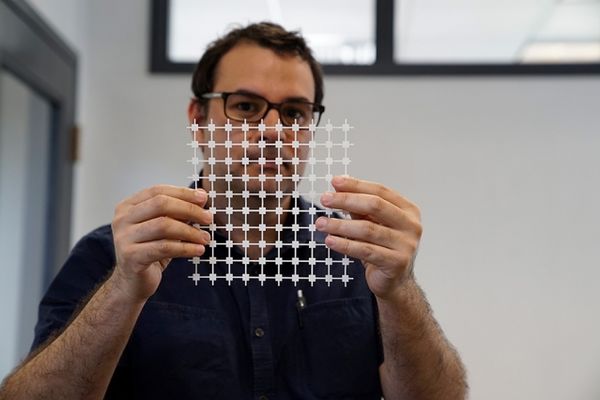
Plug-and-play diagnostic devices
"Researchers at MIT’s Little Devices Lab have developed a set of modular blocks that can be put together in different ways to produce diagnostic devices. These “plug-and-play” devices, which require little expertise to assemble, can test blood glucose levels in diabetic patients or detect viral infection, among other functions. “Our long-term motivation is to enable small, low-resources laboratories to generate their own libraries of plug-and-play diagnostics to treat their local patient populations independently,” says Anna Young, co-director of MIT’s Little Devices Lab, lecturer at the Institute for Medical Engineering and Science, and one of the lead authors of the paper. Using this system, called Ampli blocks, the MIT team is working on devices to detect cancer, as well as Zika virus and other infectious diseases. The blocks are inexpensive, costing about 6 cents for four blocks, and they do not require refrigeration or special handling, making them appealing for use in the developing world. “We see these construction kits as a way of lowering the barriers to making medical technology,” says Jose Gomez-Marquez, co-director of the Little Devices Lab and the senior author of the paper." [...]

Graphene-based sensor learns to feel like a human
"Sensor beats humans in fabric touch test Researchers in South Korea have combined an electric sensor with a machine-learning algorithm to create a device that can feel and distinguish different surface textures. The device could find use in virtual reality, robotics and medical prosthetics. Machines can already recognise and replicate patterns associated with human speech and vision. Touch, however, is more complex to mimic because it relies on mechanoreceptors in our skin that sense tiny changes in pressure and vibrations when we touch different surfaces. Now Wanjun Park and his colleagues at Hanyang University in South Korea have taken a significant step towards human-like touch sensing with a sensor made of a graphene-flake film supported on a robust polyethylene naphthalate substrate. The device detects changes in electrical conductance and resistance through the graphene film when the film is deformed." [...]

Email encryption standards hacked
"Security gaps in the standard encryptions enable attackers to read confidential emails. A research team from the University of Applied Sciences (FH) in Münster, Horst Görtz Institute for IT Security at Ruhr-Universität Bochum (RUB), and Katholieke Universiteit Leuven has demonstrated that the two most common email encryption standards are vulnerable to attacks. Their attack, referred to as Efail, proved successful in 25 out of 35 tested email programs using the S/MIME encryption standard and in 10 out of 28 tested programs using OpenPGP. The program developers have been informed and have fixed the security gaps. The experts urgently recommend updating the underlying cryptographic algorithms in order to withstand any potential attacks in future. Detailed information on their attack has been published on their website." [...]
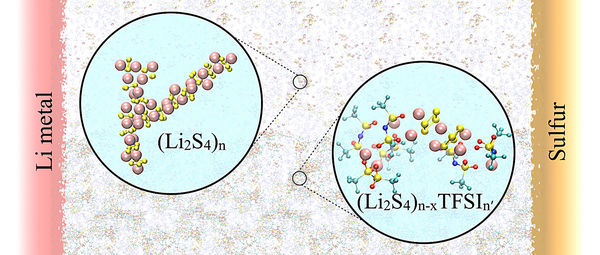
Keeping Tabs on Polysulfides in Batteries
"Optimizing lithium-sulfur battery electrolytes for long life. The Science In the future, lithium-sulfur (Li-S) rechargeable batteries could hold more energy and cost less than lithium-ion batteries if they can be made to last longer. A key challenge is preventing the polysulfide ions that must form at the sulfur electrode during discharge from being transported through the liquid electrolyte to the other electrode. Here, researchers discovered how the solubility and transport of polysulfide ions in the liquid electrolyte relates to the chain length of the polysulfide ion, the tendency of the ion to cluster, and the amount of lithium salt present in the electrolyte. It is noteworthy that polysulfides of any chain length or structure dissolved in the liquid electrolyte can contribute to poorer performance of the battery. The Impact Increasing the lifetimes of lithium-sulfur rechargeable batteries requires preventing polysulfide transport between electrodes during operation." [...]

NEC and AIST Develop Efficient Technology for Discovery of Rare Critical Events by Merging AI and Simulation Technologies
"NEC Corporation (NEC) and Japan's National Institute of Advanced Industrial Science and Technology (AIST) today announced a new efficient search technology for the discovery of rare critical events. The technology repeats simulations while artificial intelligence (AI) learns the simulation results. As a result, it efficiently discovers rare critical events that are difficult to discover at the product design stage due to the extremely low probability of their occurrence. The technology is one of NEC's lineup of cutting-edge AI technologies "NEC the WISE" (*1). The new technology merges AI and simulation technologies to improve the efficiency of search for rare events. It significantly shortens validation time (the time taken for highly-skilled experts to discover such rare events at the product design stage) and reduces the risk of multiple critical events being overlooked." [...]
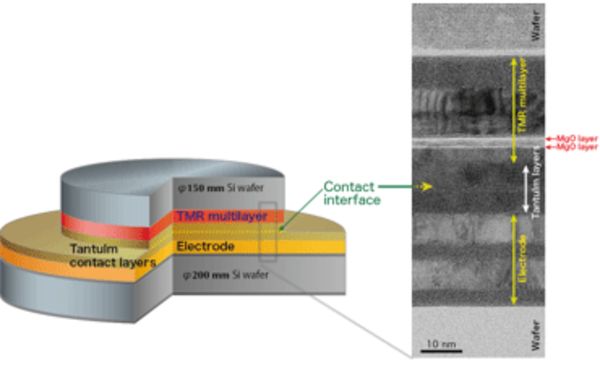
Development of a 3D Stacking Process for Non-Volatile MRAM
"The researchers have developed a stacking technology for a magneto-resistive random access memory (MRAM) to separately form a single-crystal tunnel magneto-resistive (TMR) thin film and then bond it to a CMOS. New Results Until now it was not possible to form a single-crystal TMR device on a polycrystal metal wire. However, this has been made possible by using a 3D stacking process to separately form a single-crystal TMR thin film on a single-crystal silicon wafer and then bond it to a CMOS on another wafer. This technology provides the possibility of using single-crystal materials in the fabrication of MRAM devices. Use of a single-crystal material reduces the variation in its thin film, i.e. the variation among TMR devices to a very low level, when increasing device capacity (miniaturization of TMR devices), and a wide variety of high-performance single-crystal materials can be used." [...]

A micro-thermometer to record tiny temperature changes
"Scientists at Tokyo Institute of Technology (Tokyo Tech) and their collaborators in Swinburne University of Technology have developed a micrometer-wide thermometer that is sensitive to heat generated by optical and electron beams, and can measure small and rapid temperature changes in real time. This new device can be used to explore heat transport on the micro- and nano-scales, and in optical microscopy and synchrotron radiation experiments. There is an urgent need for a device that can measure thermal behavior on the nanoscale and in real time, as this technology could be applied in photo-thermal cancer treatment as well as in advanced research on crystals, optical light harvesting, etc. Moreover, a miniaturized thermal microscopy system with a nanoscale heat source and detector is essential for future development of next-generation transistors that will be employed in designing new nanoscale devices. A thermocouple is an electrical device consisting of two dissimilar electrical conductors forming electrical junctions at differing temperatures. A thermocouple produces a temperature-dependent voltage, which can be interpreted to measure temperature." [...]
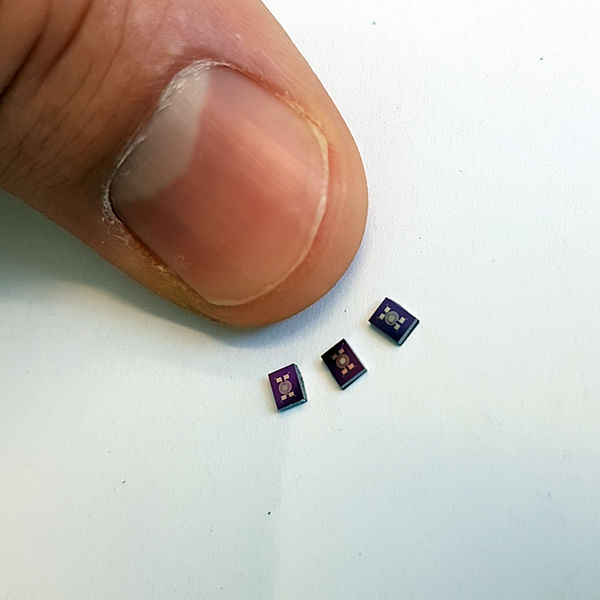
An electronic rescue dog
"ETH Zurich scientists have developed the smallest and cheapest ever equipment for detecting people by smell. It could be used in the search for people buried by an earthquake or avalanche. Trained rescue dogs are still the best disaster workers – their sensitive noses help them to track down people buried by earthquakes or avalanches. Like all living creatures, however, dogs need to take breaks every now and again. They are also often not immediately available in disaster areas, and dog teams have to travel from further afield. A new measuring device from researchers at ETH Zurich led by Sotiris Pratsinis, Professor of Process Engineering, however, is always ready for use." [...]
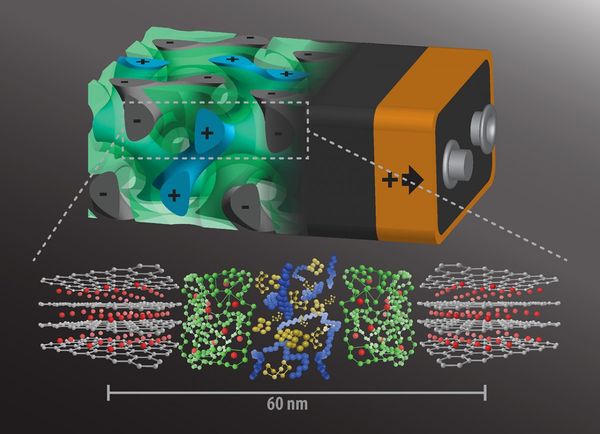
Self-assembling 3D battery would charge in seconds
"The world is a big place, but it’s gotten smaller with the advent of technologies that put people from across the globe in the palm of one’s hand. And as the world has shrunk, it has also demanded that things happen ever faster – including the time it takes to charge an electronic device. A cross-campus collaboration led by Ulrich Wiesner, the Spencer T. Olin Professor of Engineering in the Department of Materials Science and Engineering, addresses this demand with a novel energy storage device architecture that has the potential for lightning-quick charges. The group’s idea: Instead of having the batteries’ anode and cathode on either side of a nonconducting separator, intertwine the components in a self-assembling, 3D gyroidal structure, with thousands of nanoscale pores filled with the components necessary for energy storage and delivery. “This is truly a revolutionary battery architecture,” said Wiesner, whose group’s paper, “Block Copolymer Derived 3-D Interpenetrating Multifunctional Gyroidal Nanohybrid for Electrical Energy Storage,” was published May 16 in Energy and Environmental Science, a publication of the Royal Society of Chemistry. “This three-dimensional architecture basically eliminates all losses from dead volume in your device,” Wiesner said." [...]
Modelos 3D
Com a disponibilidade de ferramentas que permitem dar azo a nossa imaginação na criação de peças 3D e espaços como o thingiverse para as publicar, esta rubrica apresenta alguns modelos selecionados que poderão ser úteis.

Triangle to Square - Magic Triangle
"The Famous magic triangle, a triangle which can tranform itself to a square, or a square which can transform itself to a triangle ! I used a 4/40 - 1/2" machine screws to attach the 4 parts together. " [...]
Projetos Maker
Diversos Projetos interessantes.
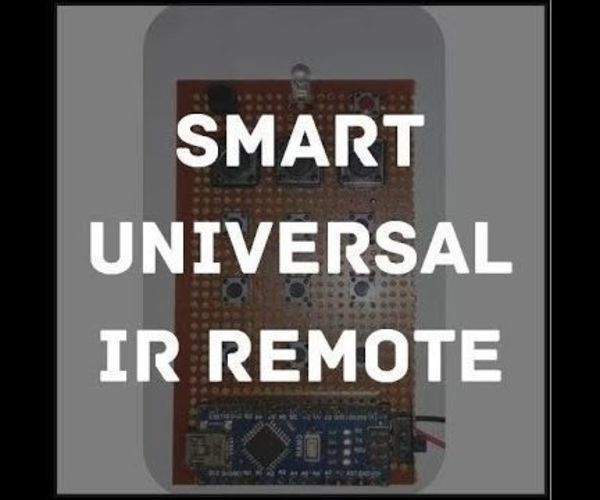
Smart Universal IR Remote
"Introducing the Smart Universal IR Remote !! !A simple, compact & much powerful tool to conquer all the IR devices around you !!! Everything all at just few bucks.... Why Smart ??? It can learn the actions of any button on any IR remote very easily, allowing you to modify the actions as per you requirement. These actions once taught, get stored in the non-erasable memory of the Arduino Nano. So, no need to re-assign the controls to its buttons." [...]

Lockable Gift Box
"A giftbox where you can type select the initials of who it is to and who it is from using a potentiometer dial. " [...]
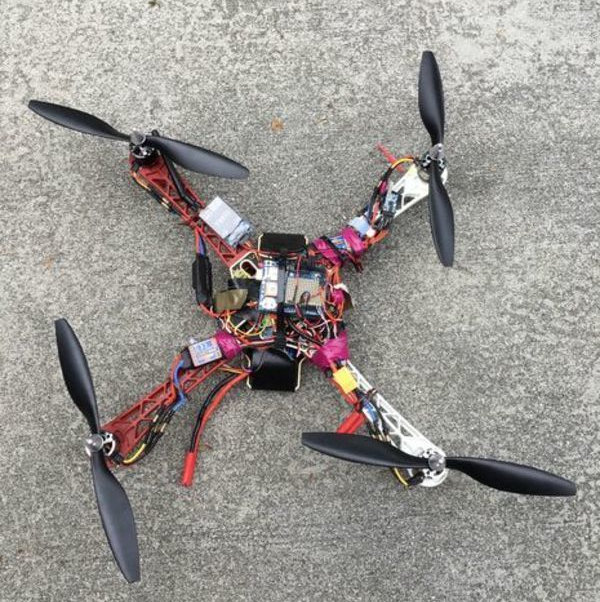
Arduino Drone With GPS
"We set out to build an Arduino-controlled and stabilized, GPS-enabled first-person-view (FPV) quadcopter drone with return to home, go to coordinate, and GPS hold functions. We naively assumed that combining existing Arduino programs and wiring for a quadcopter without GPS with those of a GPS transmission system would be relatively straightforward and that we could quickly move on to more complex programming tasks. However, a surprising amount had to change in order to mesh these two projects, and thus we ended up making a GPS-enabled FPV quadcopter, without any of the added functionality. We have included instructions on how to replicate our product if you are happy with the more limited quadcopter. We have also included all the steps we took on the way to a more autonomous quadcopter. If you feel comfortable digging deep into Arduino or already have a lot of Arduino experience and would like to take our stopping point as a jumping-off point for your own exploration, then this Instructable is also for you." [...]
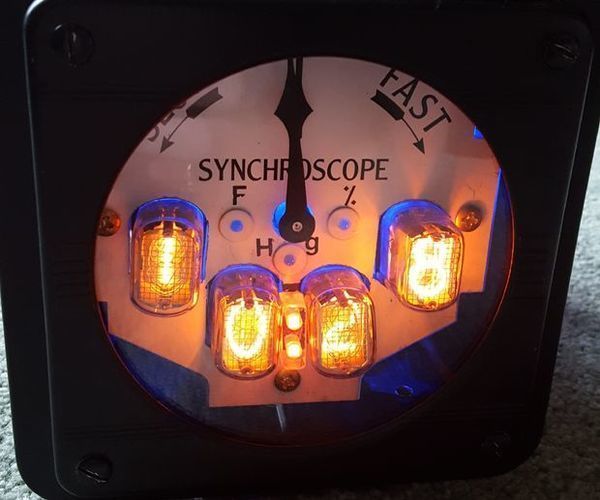
Arduino Nixie Clock & Weather Station
"I wanted to build a Nixie clock driven by an Arduino and found a few places on the internet, but none were 100% complete to get it working from the beginning to end. I either found bad wiring diagrams, bad code in programs or bad supporting literature that really slowed down my progress, so I gutted it out, figured it out and came up with the following. Maybe someone can say well, you missed this or that... Hopefully i haven't and I have given you enough here to let you find the mistakes. Anyway... this is my Nixie clock / Weather station. I used a Syncroscope from a Nuclear power plant for the case. The clock displays the time from the top of the minute to 15 sec in, and then displays the temperature (F), then back to time until the bottom of the minute (30 sec." [...]
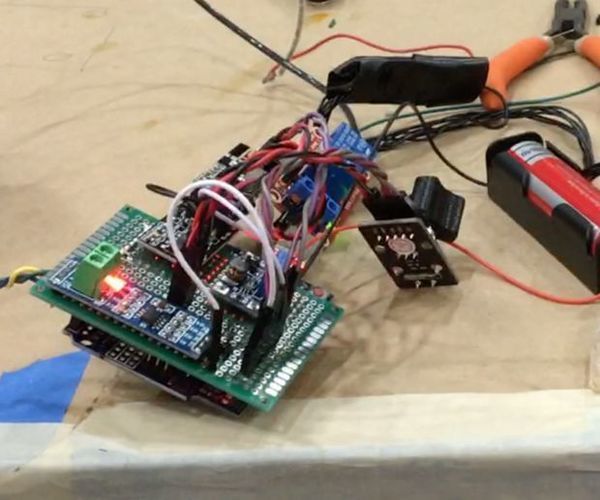
NRF24L01 DMX Relay Module
"Transmit DMX over NRF24L01 to an Arduino controlled relay module Step 1: Materials - 2x Adruino Uno - 2x NFR24L01 2.4GHz Module - 2x Socket Adapter plate Board for 8Pin NRF24L01 Module - 2x MAX485 Module - 1x 5v Relay Module - 1x TM1637 4 Digit 7 Segment Display - 1x Rotary Encoder (5pins, push switch) - 1x 3D printed rotary encoder knob - 1x Male 3pin DMX connector - 2x Male 3pin DMX connector - Atleast 3 >5v LEDs - 2x DC-DC SX1308 Step-UP Boost Converter 2-24V to 2-28V 2A - 2x 3.7 A Batteries and battery holders - 1x 12v Battery - 1x 12v LED Various resistors and wire based on your parts and set up I could not find a large enough PCB to use on Fritzing, so I left my diagrams on the breadboard, but the goal of this project is to produce PCB Shields for your Arduinos. You will want two different shields, one for your transmitter and one for your receiver. I have attached a bunch of pictures of how I laid out my receiver, but this was my first time working on a PCB and I definitely think you can come up with a more efficient version of your own. In the next steps I will have fritzing of the breadboard layouts so you can at least see where all the connections are made. If you need a deeper step by step of the breadboard see my "DMX Relay Module" Instructable, but please note that some of the pins needed to change so you will need to watch that if you decide to look at those fritzings" [...]

Digital Circuits 6: An EPROM Emulator
"I recently designed and breadboarded a simple Z80 based computer. This was the sort of thing I did for fun and profit years ago. This time it was, well, for fun and profit. But it was a little different. Back in the day I had a drawer full of Erasable Programmable Read-Only memory chips (EPROMs), as well as an EPROM eraser and programmer*. This time I had none of that." [...]
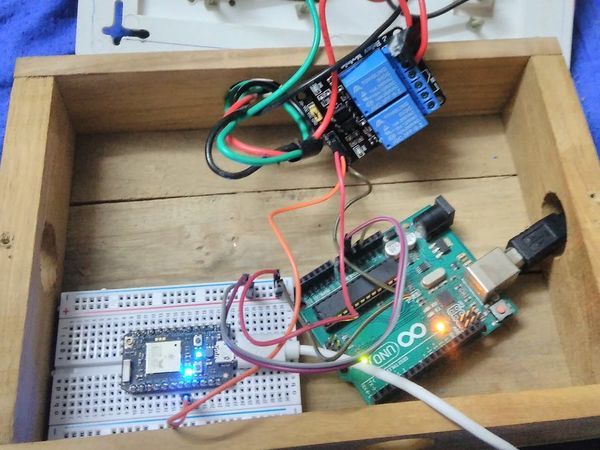
Smart Energy Saver for Your Home
"My aim is to minimize the loss of electricity there is when people forget to switch off their fans or lights, through smart home solution. Story There is a lot of electricity loss in homes due to the fans and lights that are kept on even when no one is present in the room. My idea is basically to inform a user that when he leaves his/her home, if any of the basic appliances like the fans or lights, televisions, fans or air conditioners are left on accidentally, which are the basic and major electricity consuming appliances of our house. Some appliances like televisions and air conditioners consume electricity even when just their switch board switches are on, it isn't much but a cumulative sum of a 1000 houses with the same condition would be a large enough number. I have currently used an homemade extension device to demonstrate the working of the project. The following are the steps to create this fun project, so lets get started :" [...]

How to Make a Mini Tesla Tower
"The concept of wireless electricity was introduced around 100 years ago and even today, it is one of the most fascinating and exciting topics for scientific research & development. It was the great scientist Nikola tesla, who actually demonstrated the transmission of electricity wirelessly. In this Instructable, I decided to make a mini Tesla Tower (similar to a Slayer Exciter), that can power ON any Fluorescent or neon lights wirelessly. However, the concept of wireless electricity is quite different than the concept of slayer exciter. This device can only glow fluorescent and neon lights without actual transmission of electricity whereas wireless transmission devices actually transmit electrical power through electromagnetic Induction. This is a great project for having fun, experimenting, demonstration in exhibitions and also showing magic tricks." [...]
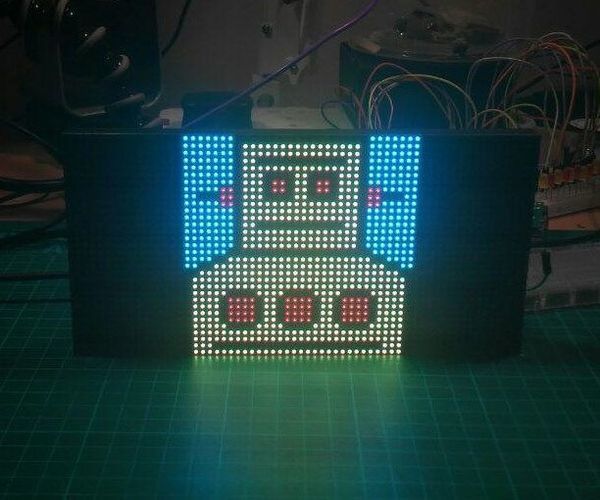
RGB LED Matrix With an ESP8266
"I think these RGB LED Matrix displays are one of best displays you can get for your Arduino projects, they are incredibly bright and vivid and are actually pretty easy to use too! They can be used for displaying text, images or a combination of both Check out some of the examples of what can be done with the display: Displaying Text Displaying Images YouTube Subcriber counter In this Instructable I'll show you how to get started with using these displays with an ESP8266.Let's jump into it! " [...]
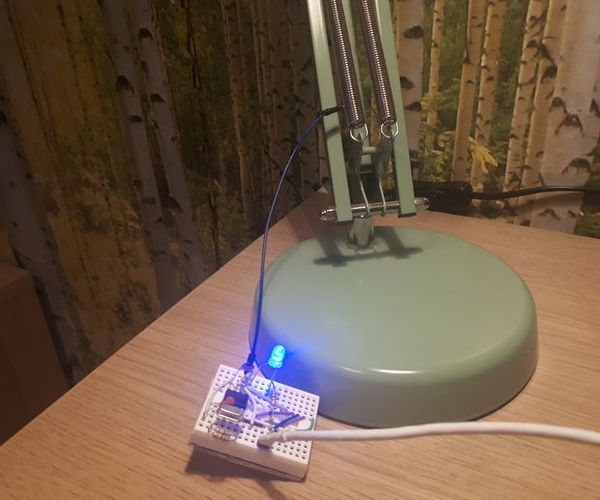
Capacitive Touch With PIC12F675
"This tutorial will show you how to make a capacitive touch sensor using the PIC12F675. Due to its limited memory space the software is made in assembler. " [...]
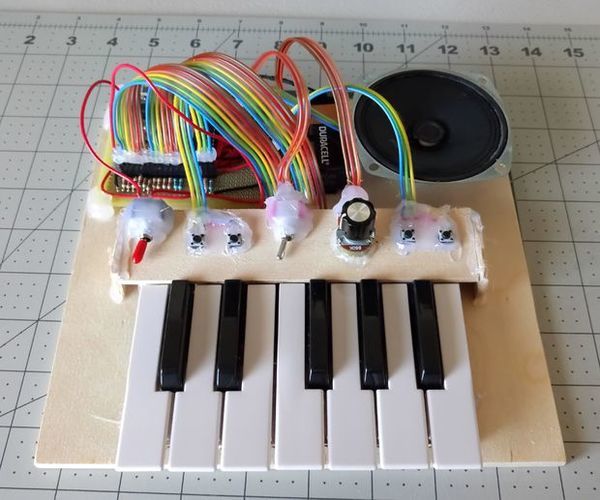
Arduino Synth / Tone Generator
"This is a Synth / Tone Generator that uses the Tone command that is native to the Arduino. It has 12 individual keys that can be set up to play any frequency of square wave. It has the ability to go up and down octaves with a button. It also has a second Arduino that will generate a "beat" and you can cycle through each beat and adjust the tempo of the beat with the potentiometer. It outputs to a single speaker. It might look complicated but it is actually pretty straightforward to make and you can customize your sounds by changing the code." [...]
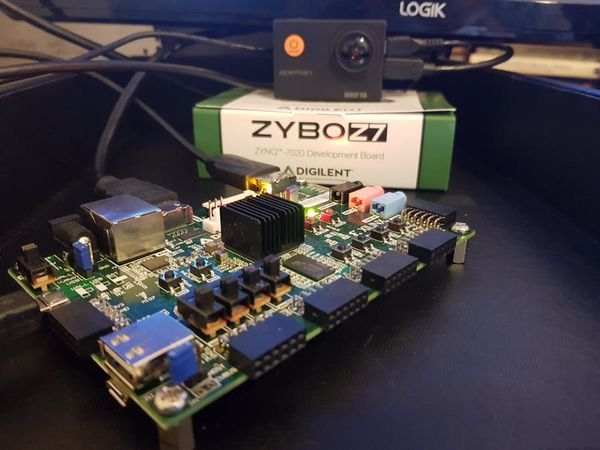
Creating a Zynq or FPGA-Based, Image Processing Platform
"Creating an image processing platform that enables HDMI input to HDMI output. This can be used as a base for HLS-based image processing demo. Story This project will demonstrate how to create a simple image processing platform based on the Xilinx Zynq. This project will then be used as a base for later developments which focus upon High-Level Synthesis based development which allows the use of the industry standard OpenCV library. To create this example I am using a Zybo Z7 as it provides both HDMI input and output, along with a CSI-2 interface for a MIPI camera which we can use also for future developments. In addition to the Zybo-Z7 we will be using: HDMI Camera e.g." [...]

The JClock
"Hello, my name is James Hubbard and I created this clock that I call the jClock. It uses a ds1302 real time clock module that can keep time more precisely than the Arduino can. This is what you will need to build it: 1. Arduino Uno. 2. ds 1302 rtc (real time clock) 3. Temperature sensor model TMP36 4." [...]

RC Rover Controlled by Gestures Motions & Joyestick
"RC Rover is a Robotics project that aims to improve rover control through the use of radio frequency and the interaction of rover movement with hand movement using the inertial unit (MPU6050), but also the control of this Rover with a Joyestik. All this is done remotely using the radio frequency Nrf24l01 (2.4Ghz) . This project is realized using open source development boards (Arduino), one for data transmitter (main command) whitch contains the Joyestik and the inertial unit and one for the receiver (control of the engines),for the transmission i used (Arduino Pro Mini Board ) for the receiver i used (Arduino Uno board )" [...]
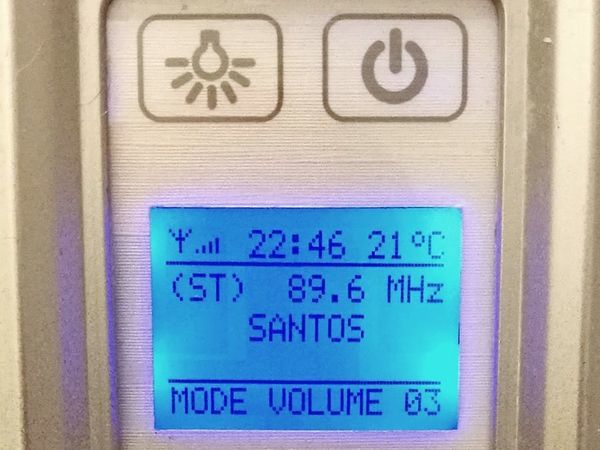
Arduino-Based Shower Radio
"I have a music in my shower cabin again! Story Few years ago I bought a chinese shower cabin which has installed the TR028 control system with radio. Unfortunately one nice day I found this system competely dead. Nobody could repair it so I bought another, cheaper shower radio. It dead after about one ear. :( My family used to have a radio in the shower cabin, so I started studiyng how these radios were made." [...]
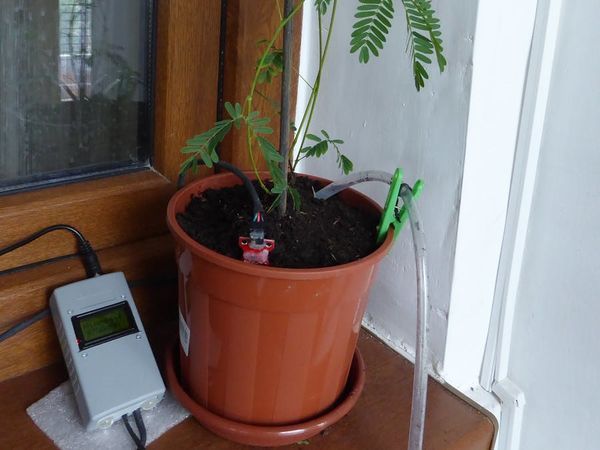
ATtiny85 Plants Care
"The project is for watering the plant, so you just visit it from time to time! Small price and number of components! Story Mimosas are sensitive plants. If left without water for a week (whether because of holiday or you simply forget), you will be sorry! There are many Arduino projects dedicated to this objective, but it depends on what you want: Receive a warning (alarm sound, SMS, etc.) and you must go water the plant?" [...]

Arduino Inverted Magnetron Tansducer Gauge Readout
"As part of an ongoing project of mine here, documenting the ongoing progress of my foray into the world of Ultra High Vacuum particle physics, it came to the part of the project that required some electronics and coding. I purchased a surplus MKS series 903 IMT cold cathode vacuum gauge, with no controller or readout. For some background, ultra high vacuum systems need various sensor stages to properly measure the lack of gases in a chamber. As you get a stronger and stronger vacuum, the more complicated this measurement ends up. At low vacuum, or rough vacuum, simple thermocouple gauges can do the job, but as you remove more and more from the chamber, you need something akin to an gas ionization gauge. The two most common methods are hot cathode and cold cathode gauges." [...]
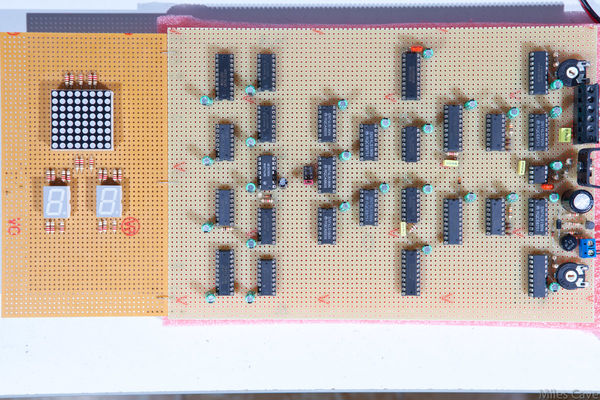
SPEBEG (Single Player Eight Bit Electronic Game)
"Finally got around to finishing the last details of an old shcool project. A simple 8bit game, aim with the joystick at the target and fire! Increase points and try to keep up with the increasing speed! " [...]
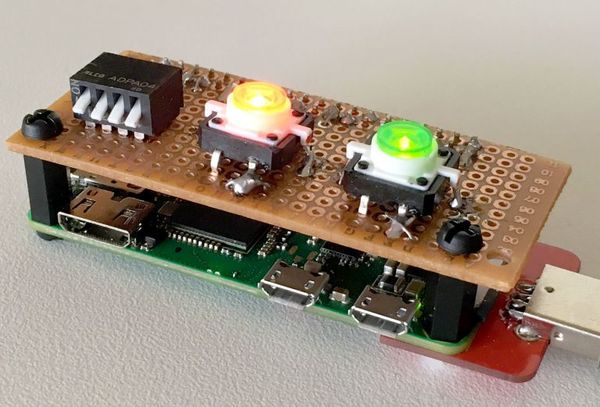
Poor mans Bash Bunny
"I have been looking at the BashBunny from Hak5 for some time, and thought to myself that it was quite expensive. I wanted to play with the same powerful tools, so I decided to build my own cheap-ass version from a Raspberry Pi Zero WiFi. After looking around the internet I found a couple of projects to build on: PiBunny and rspiducky. The nice work was not complete and didn’t do exactly what I needed. After some soldering, coding and messing around with other peoples code, I ended up with my Bunny-version with these features: A Raspberry Pi you stick into a PC that acts like a keyboard, a mass storage device, a serial device, and an RNDIS-ethernet adapter. 16 boot modes that can be set by a 4xDIP switch." [...]

GPS Clock Time Adjusted to Timezone and Daylight Saving Time
"In this instructable I share with you my gathering of useful components in Arduino code. If you have a GPS receiver, why not use the time of the GPS satellites displayed in the time of your timezone. " [...]
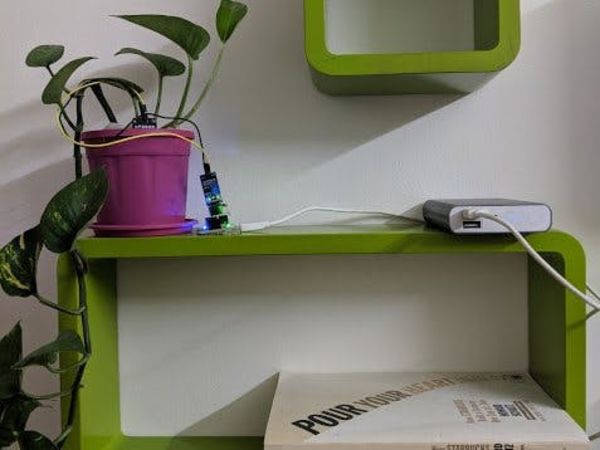
Build a Smart Garden with IoT Plant Monitoring System
"Monitor the sunlight and water content of your plants and get alerts when you need to act. No coding. Just drag and drop the logic. In today's busy world we forget to nourish and water plants that makes our home clean and soothing. Think about 'it what if your plants are able to tell you when they are happy and when they require proper attention. It would be awesome right!" [...]
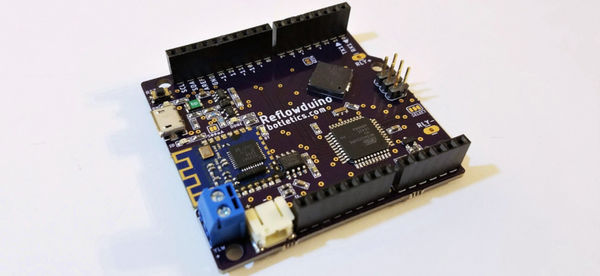
Reflowduino
"Overview The Reflowduino project is an entire do-it-yourself (DIY) reflow ecosystem consisting of open-source hardware specifically built to make it easy to control reflow appliances and apply PID temperature control while maintaining full flexibility in programming and usage while offering a bunch of features. Since I'm a firm believer of great online resources having learned everything on my own aside from my Mechanical Engineering degree, I'm sharing all of this as completely open-source for everyone to enjoy, including EAGLE PCB files, Arduino IDE example code, sample Android app for Bluetooth control, and full tutorials on how to modify a toaster oven to start cookin’! That being said, I do offer the boards listed below for sale on my website. Each order helps me out a little bit in creating and sharing new projects with everyone! :)" [...]

Ultrasmall Ultrastable DIY UHF Spy Bug
"My latest and for now last miniature audio spy bug and you can build it too! Works at 433MHz, is superstable due to the use of a SAW resonator and uses a single 1.5V button cell! " [...]
3D Printed NeoPixel Ring Butterfly With Tinkercad
"Combine the rainbow lights of NeoPixels with 3D printing to program, design, and assemble a groovy, illuminated butterfly! This is a great project to dive into basic electronics and programming using Arduino and NeoPixels, and to combine electronics with 3D design using Tinkercad and 3D printing. This project uses the following electronic parts: Arduino Uno with USB cable24 NeoPixel RingJumper wires (you only need 3 from this set)We've also created wishlists on Sparkfun and Adafruit for these components. You'll also need the following tools: Soldering iron and solder (also available from Adafruit and Sparkfun)Wire strippers (also available from Adafruit and Sparkfun)Wire cutters/snips (also available from Adafruit and Sparkfun)Helping hands (optional but handy for holding your parts in place when you solder - also available from Adafruit and Sparkfun)For more info on getting started and leveling up with 3D printing, check out one of the free Instructables classes on 3D printing. This is an intermediate level Arduino project, so if you're an ultra-beginner or a bit rusty, brush up with the free Instructables Arduino Class or the earlier Arduino Tinkercad lessons. First, you'll first learn how NeoPixels work by programming a NeoPixel ring to light up every color of the rainbow in the Tinkercad Circuit simulator: After that, you'll customize a 3D butterfly design in Tinkercad that attaches to a special holder for securing your design and a Neopixel ring to an Arduino Uno." [...]
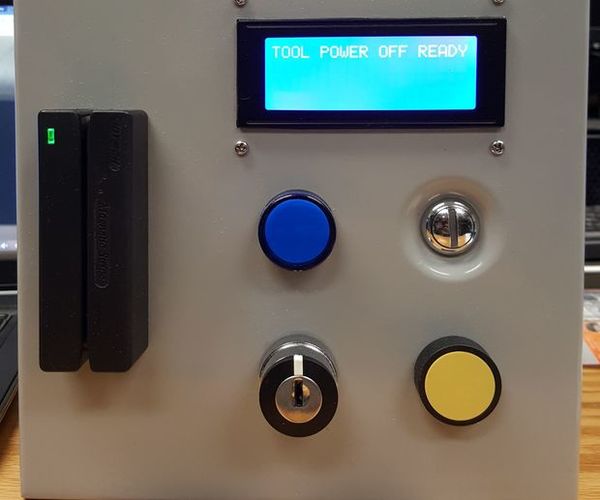
Card Reading Shop Power Switch
"This box reads any card with a magnet strip and, if you're on the registered personnel list, turn on the shop power via a relay. A sole person, to be added to the program file upon creation, has the power to add others to this list for the utmost security. " [...]
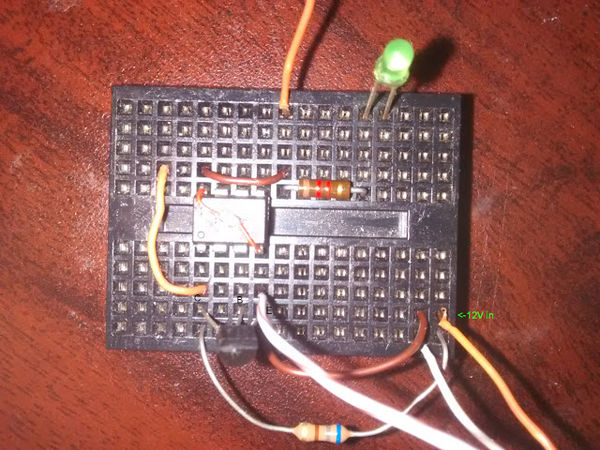
PiggyFuse HVSP AVR fuse programmer
"Although I've been working with AVR MCUs for a number of years now, I had never made a high voltage programmer. I've seen some HVSP fuse resetter projects I liked, but I don't have a tiny2313. I think I was also hesitant to hook up 12V to an AVR, since I had fried my first ATMega328 Pro Mini by accidentally connecting a 12V source to VCC. However, if you want to be an expert AVR hacker, you'll have to tackle high-voltage programming. Harking back to my Piggy-Prog project, I realized I could do something similar for a fuse resetter, which would simplify the wiring and reduce the parts count. I considered using a charge pump to provide 12V, like some other HVSP projects do, but adding at least 3 diodes and capacitors would more than double the parts count." [...]

Autonomous RC Car
"With the rise of self-driving, autonomous cars today, I decided to take on the challenge of making one of my own. This project also served as my capstone project in my Engineering Design and Development and Robotics classes and received an award for best autonomous vehicle at a high school STEM competition. Instead of starting from scratch, I opted to use an RC car that we already had and paired it with a RedBoard Arduino Uno board. I chose the Arduino due to its relative ease of use and programming. For those wondering, this car has a Redcat Racing 03061 Splash-Resistant ESC with a brushed motor. The ESC was already programmed using the controller that came with the car." [...]
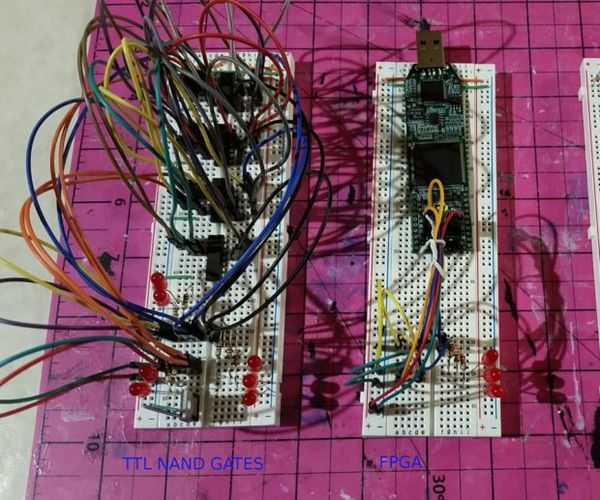
Arduino As a Cheap Breadboard FPGA
"Designing hardware logic circuits can be fun. The old school way to do this was with NAND gates, on a bread board, wired up with jumper wires. This is still possible, but it doesn't take much before the number of gates gets out of hand. A newer option is to use an FPGA (Field Programmable Gate Array). These chips can rewire themselves to become any digital logic circuit you can design, but aren't cheap and readily available. I will show how this FPGA can be replaced with a cheap Atmega chip from an Arduino UNO, effectively putting the digital circuit into a DIP package, which is very breadboard friendly." [...]

BWOOM Mask Reimagined + Arduino
"BWOOM Mask is from the Democratic Republic of the Congo in Central Africa. Unlike most art, it was designed to be used in African masquerades. The mask was used in dance and other rituals and shook back and forth on a person's face making its mobile appearance differ from its stationary one. Using persistence of vision optical effects, I've made some interesting visual illusions with this mask and other objects/figures. I use a motor setup, LED lighting and an arduino microcontroller to create these images. " [...]
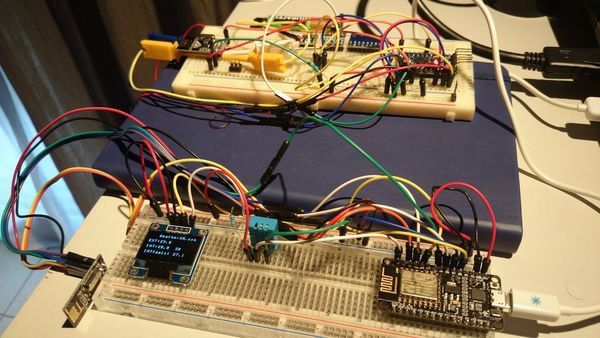
Weather Pyramid
"Measures wind speed via inertial sensors and rain with capacitive. Maintenance free, LPWAN, 3D printed DESCRIPTION This is not yet another automatic weather station! This is an all-in-one completely solid-state, maintenance free, energy and communications autonomous weather sensing device, designed for mass scale deployment. Novelties include, wind speed and direction measurements using inertial sensors and rain intensity measurements using capacitive sensors, with a 3D printed enclosure having an active role in sensing. Weather Pyramid will connect to the Internet using low power, long range wireless technology (LPWAN such as LoRaWAN, SIGFOX, NB-IoT) and over WiFi (for urban deployments or development purposes) and runs on batteries charged with solar power. Weather Pyramid aims to start an open-hardware framework (competitive to the traditional commercial weather stations), to overcome the weather data availability global problem." [...]

Drone Claw
"In this project we’ll show you how to build a DIY Drone Claw. We designed and 3D Printed a claw attachment for the DJI Mavic Pro. This doesn’t obstruct the vision sensors so we can fly safely with obstacle avoidance. This build can be used for educational projects like the classic egg drop or even delivering small objects. You can also use this to pick up the trash, carry objects to research sites or even camping grounds. There’s a lot of tasks that you can do with a claw attachment." [...]

IOT123 - Idc Cable Tester (6 Wire)
"In developing the ICOS10 ASSIMILATE SENSOR HUB, I needed to verify the cables I was creating. The verification was to check continuity between the sockets and isolation between the wires. The design I came up with used DIP switches to change between continuity and isolation tests. As I expect to have a different board for each tests (the DIP Switches aren't built for constant use), the two circuits can be hard-wired without the need for DIP Switches, The same design principles can be applied to larger (wire number) connectors as well. " [...]
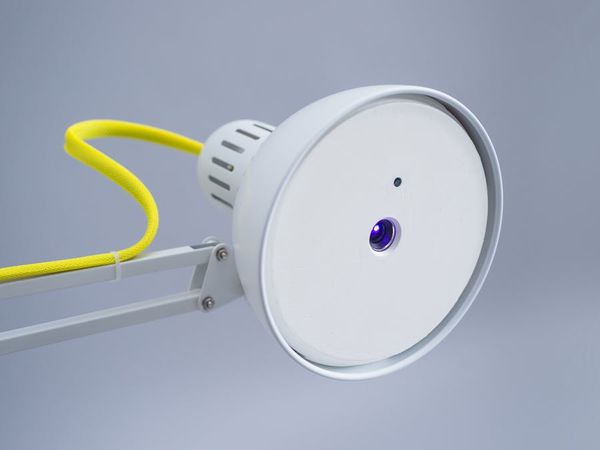
Lantern
"An Ikea hack that transforms any surface into an ambient, smart interface using Raspberry Pi, a laser projector, and Android Things. Lantern combines an Ikea lamp, laser projector and Android Things to create a connected projector that explores the relationships between surfaces and content. It is built around the concept of ‘channels’ – mini apps that can be configured through the companion app, connect to data feeds online and display a projected UI. " [...]
That's all Folks!


